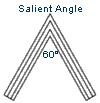 An
angle in a fortification's trace that pointed outwad toward the xterior of
the fortification. In field fortifications salient angles were to be made
as obtuse (flattened) as possible to reduce the sector without fire on either
side of the capital of the angle and never less than 60° to avoid camping
the interior arrangements of the parapet and prevent rapid destruction of
the parapet by erosion. Salient angles were generally considered the primary
points of attack since less fire could be developed from the point of the
salient along the capital on ground immediately exterior to the work than
along faces and flanks. The vulnerability of salients to attack could be
mitigated by flanking arrangments built into the trace and by positioning
artillery to fire along the line of the capital. Faces joining to form a
salient were also vulnerable to enfilade and ricochet fire and often had
to be defiladed by adjusting the height of the parapet at the salient or
using traverses along the interior sides of the faces' parapets. An
angle in a fortification's trace that pointed outwad toward the xterior of
the fortification. In field fortifications salient angles were to be made
as obtuse (flattened) as possible to reduce the sector without fire on either
side of the capital of the angle and never less than 60° to avoid camping
the interior arrangements of the parapet and prevent rapid destruction of
the parapet by erosion. Salient angles were generally considered the primary
points of attack since less fire could be developed from the point of the
salient along the capital on ground immediately exterior to the work than
along faces and flanks. The vulnerability of salients to attack could be
mitigated by flanking arrangments built into the trace and by positioning
artillery to fire along the line of the capital. Faces joining to form a
salient were also vulnerable to enfilade and ricochet fire and often had
to be defiladed by adjusting the height of the parapet at the salient or
using traverses along the interior sides of the faces' parapets. |